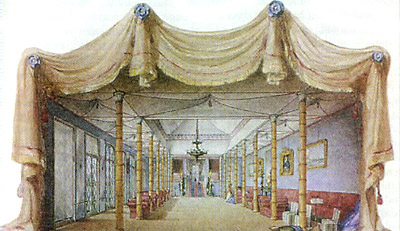
Genesee Country Magazine
Greatest Hits
Search Our Website!
 |
Genesee Country Magazine | Search Our Website! |
Related
Links: | GC Magazine Home | GC Greatest Hits | Clarion Publications | WNY Travel Guide |
The Other Hartford HouseDigging out the British roots of a very American home
|
 |
The famed tent room was a favorite spot for entertaining at St. Dunstan's. The design was thought to be inspired by a tent built for George IV to celebrate the victory at the Battle of Waterloo in 1812. |
After the birth of two children Maria and the 3rd Marquis became estranged with Maria and the children removing to Paris. The separation could have surprised no one as the Marquis had not allowed marriage to interfere for one moment with a life seemingly dedicated to debauchery. Indeed his every waking hour appeared to have been spent almost entirely in indulging his licentious desires and his other great passion as a connoisseur of fine art. His eye was so well trusted that he was given the duty of acquiring artworks on behalf of King George IV.
Despite his dishonorable, even scandalous reputation, the Marquis's great wealth and aesthetic discernment meant that he maintained a wide array of friends and acquaintances who readily flocked to his lavish social gatherings. In order to entertain this army and to enhance his own pleasure in being shamelessly extravagant, he built a glorious villa in Regent's Park. It was here at about the time of the final completion of this palace of pleasure in 1834 that he entertained the relatively innocents from abroad, newlyweds James and Mary Wadsworth.
Regent's Park had been created by the Prince of Wales after he became Regent for his father George III who had finally become incurably insane in 1811. The plan conceived by architect John Nash was to have an elegant thoroughfare (the modern Regents Street) to connect the Prince's official residence in the city with a new summer villa to be constructed in a park-like suburban area of London. Although the Prince's villa was never built, the park did become the playground of the 3rd Marquis as well as the home of the London Zoo.
The Marquis's Villa was designed by 25-year-old architect Decimus Burton who exhibited his plans at the Royal Academy exhibition in 1822. Burton's travels had taken him to both Italy and Greece where he had studied classical ruins. He later redesigned London's Hyde Park where he created a triumphal arch, and laid out Phoenix Park in Dublin. The arch is currently being restored by English Heritage and its balcony, with views over Buckingham Palace gardens, will be opened to the public this spring.
As befitted the 3rd Marquis's ego, his Villa was the largest of all those built in Regent's Park. It had a portico of six Corinthian columns as its principal front entrance, through which visitors would pass into an elliptical salon. The roof was Venetian in style and had broad projecting eaves.
Adjacent to the west wing of the villa was the “tent room”. This great hall, draped with yards of crimson and gold curtains, provided a luxurious and capacious setting for grand balls and receptions. it was topped with a large tent-like canopy with a spiral finish of copper. It was believed to be based on the circular “tent” built by John Nash for the Prince Regent to entertain the victorious allied leaders after the Battle of Waterloo.
On the grounds, close to the tent room, the Marquis placed a huge clock recovered from demolition work on St. Dunstan's Church in Fleet Street. The clock was originally set up in 1671 at Ludgate, one of the ancient gates into the City of London, which was named for the mythical King Lud, said by some to have been the city's founder. Bells were later added and the clock was moved to the church where, as a boy, the Marquis had been fascinated by the mechanized life-size figures of Gog and Magog who struck the hours. After this historic landmark was moved to his villa, the name was changed to St. Dunstan's Villa in honor of the clock.
The great house was filled with
fine furnishings and works of art, and on the grounds, great statuary abounded.
By all accounts, the Marquis enjoyed a luxuriant, not to say decadent, lifestyle.
Indeed, one of his many nicknames was “Caliph of Regent's Park”, a reference
to both his tastes and his behavior.
According to WebCounter
you are the
person to answer the Clarion Call
©2008 Clarion Publications, Inc. All
Rights Reserved.
This site designed by Clarion Communications.